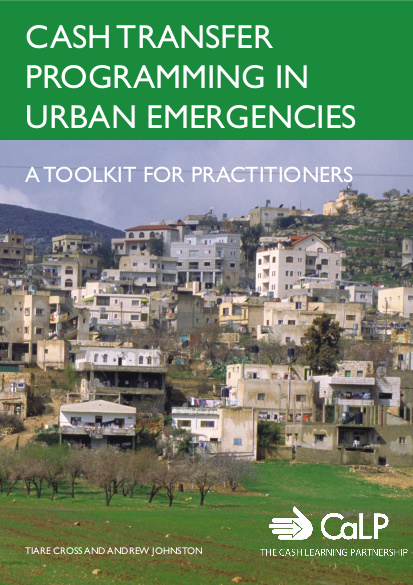
In recognition of the increasing urban populations around the world and their increasing vulnerability to disasters, the Cash Learning Partnership (CaLP), with funding from the European Commission for Humanitarian Aid (ECHO), endeavoured to investigate the current status and impact of urban emergency response programmes that utilise cash transfer programming. This study aimed to better understand the collective preparedness for future urban emergency responses, and identify concrete best practices and tools to help organisations better implement cash and voucher programmes in challenging urban environments. The following toolkit brings together the collective knowledge of best practices, key issues in programming, and adaptations of cash transfer programme methodologies for urban settings. The toolkit has been developed following more than 60 in-depth interviews with urban and cash transfer experts in the humanitarian field, two field testing missions to get real-time feedback from participants and field implementers, and rigorous review by the Urban Research Advisory Committee formed by CaLP.
The flow of the toolkit follows the logical order of a project cycle and contains both guidance and examples of tools. It is the aim of the authors to provide users of this toolkit with generic tools and guidance that can be quickly adapted for different urban settings. It is also the aim of this toolkit to promote a variety of options for implementation that reflect the multisectoral and multi-disciplinary nature of cash transfer programmes. All tools described in this toolkit are adapted from real urban projects, from a variety of organisations and contexts. Tools described in this toolkit can be downloaded from the CaLP website in MS Word, MS Excel, and MS PowerPoint format to facilitate their utilisation in the field. Additional manuals and documents listed in the bibliography provide detailed discussions on how to choose which type of cash programming, and general guidance on cash transfer implementation.
Why focus on urban emergencies? Humanitarian response programming has historically been implemented in rural contexts, and project tools have been developed for use with rural communities and social structures. Following the devastating earthquake in Port-au-Prince in 2010, flooding that inundated cities in Pakistan and the Philippines in 2010 and 2011 respectively, and food insecurity in cities such as Nairobi, Abidjan, and Gaza in the same years, practitioners faced with implementing large-scale humanitarian operations in a large urban areas acknowledged the need for further study, documentation of best practices and lessons learned, and guidance for practitioners. These large urban emergencies highlighted the need to improve speed, appropriateness, and efficiency in humanitarian programmes. Wider recognition of urban risks to disasters has prompted practitioners to invest in preparedness measures for response to urban disasters and risk reduction strategies for urban environments.
Why focus on cash transfer programmes? While working in urban environments poses many challenges, opportunities to harness the resilience of urban markets and capitalise on urban connectivity have led practitioners to see cash and voucher programming as particularly relevant in urban contexts. Work in Haiti, Pakistan, the Occupied Palestinian Territories, and Cote d’Ivoire has proved that cash and voucher programmes have a number of advantages, and warrant further consideration in our response planning.
Links
Resource collections
- Accountability to affected populations (AAP)
- Evaluating humanitarian action
- Innovation
- Topics
- UN Habitat - Urban Response Collection
- Urban Response - Urban Crisis Preparedness and Risk Reduction
- Urban Response Collection - Community Engagement and Social Cohesion
- Urban Response Collection - Economic Recovery
- Urban Response Collection - Environment and Climate Change
- Urban Response Collection - Housing, Land and Property
- Urban Response Collection - Urban Crisis Response, Recovery and Reconstruction
- Urban Response Collection - Urban Resilience
